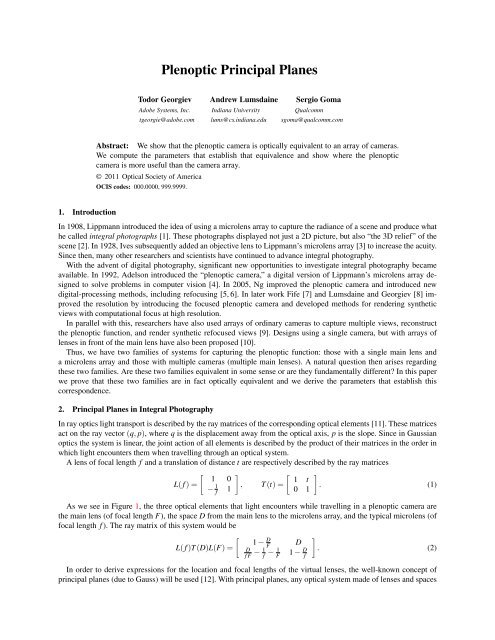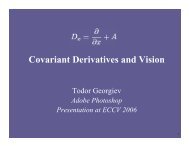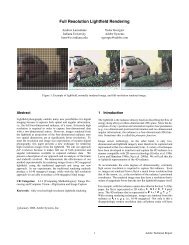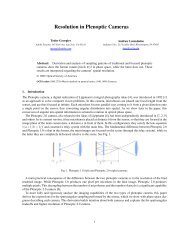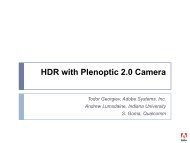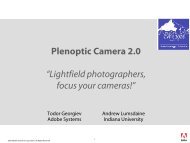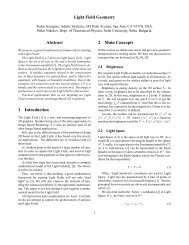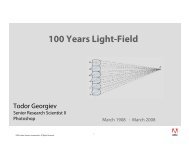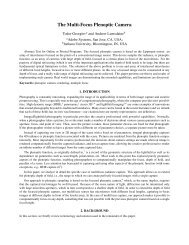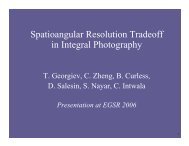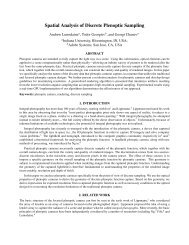Plenoptic Principal Planes - Todor Georgiev
Plenoptic Principal Planes - Todor Georgiev
Plenoptic Principal Planes - Todor Georgiev
You also want an ePaper? Increase the reach of your titles
YUMPU automatically turns print PDFs into web optimized ePapers that Google loves.
<strong>Plenoptic</strong> <strong>Principal</strong> <strong>Planes</strong><br />
<strong>Todor</strong> <strong>Georgiev</strong> Andrew Lumsdaine Sergio Goma<br />
Adobe Systems, Inc. Indiana University Qualcomm<br />
tgeorgie@adobe.com lums@cs.indiana.edu sgoma@qualcomm.com<br />
Abstract: We show that the plenoptic camera is optically equivalent to an array of cameras.<br />
We compute the parameters that establish that equivalence and show where the plenoptic<br />
camera is more useful than the camera array.<br />
© 2011 Optical Society of America<br />
OCIS codes: 000.0000, 999.9999.<br />
1. Introduction<br />
In 1908, Lippmann introduced the idea of using a microlens array to capture the radiance of a scene and produce what<br />
he called integral photographs [1]. These photographs displayed not just a 2D picture, but also “the 3D relief” of the<br />
scene [2]. In 1928, Ives subsequently added an objective lens to Lippmann’s microlens array [3] to increase the acuity.<br />
Since then, many other researchers and scientists have continued to advance integral photography.<br />
With the advent of digital photography, significant new opportunities to investigate integral photography became<br />
available. In 1992, Adelson introduced the “plenoptic camera,” a digital version of Lippmann’s microlens array designed<br />
to solve problems in computer vision [4]. In 2005, Ng improved the plenoptic camera and introduced new<br />
digital-processing methods, including refocusing [5, 6]. In later work Fife [7] and Lumsdaine and <strong>Georgiev</strong> [8] improved<br />
the resolution by introducing the focused plenoptic camera and developed methods for rendering synthetic<br />
views with computational focus at high resolution.<br />
In parallel with this, researchers have also used arrays of ordinary cameras to capture multiple views, reconstruct<br />
the plenoptic function, and render synthetic refocused views [9]. Designs using a single camera, but with arrays of<br />
lenses in front of the main lens have also been proposed [10].<br />
Thus, we have two families of systems for capturing the plenoptic function: those with a single main lens and<br />
a microlens array and those with multiple cameras (multiple main lenses). A natural question then arises regarding<br />
these two families. Are these two families equivalent in some sense or are they fundamentally different? In this paper<br />
we prove that these two families are in fact optically equivalent and we derive the parameters that establish this<br />
correspondence.<br />
2. <strong>Principal</strong> <strong>Planes</strong> in Integral Photography<br />
In ray optics light transport is described by the ray matrices of the corresponding optical elements [11]. These matrices<br />
act on the ray vector (q, p), where q is the displacement away from the optical axis, p is the slope. Since in Gaussian<br />
optics the system is linear, the joint action of all elements is described by the product of their matrices in the order in<br />
which light encounters them when travelling through an optical system.<br />
A lens of focal length f and a translation of distance t are respectively described by the ray matrices<br />
L( f ) =<br />
[ 1 0<br />
− 1 f<br />
1<br />
]<br />
, T (t) =<br />
[<br />
1 t<br />
0 1<br />
]<br />
. (1)<br />
As we see in Figure 1, the three optical elements that light encounters while travelling in a plenoptic camera are<br />
the main lens (of focal length F), the space D from the main lens to the microlens array, and the typical microlens (of<br />
focal length f ). The ray matrix of this system would be<br />
[<br />
L( f )T (D)L(F) =<br />
1 − D F<br />
D<br />
D<br />
f F − 1 f − F<br />
1 1 − D f<br />
]<br />
. (2)<br />
In order to derive expressions for the location and focal lengths of the virtual lenses, the well-known concept of<br />
principal planes (due to Gauss) will be used [12]. With principal planes, any optical system made of lenses and spaces
etween them can be replaced with an optically equivalent system consisting of space from the entrance to the “first<br />
principal plane”; followed by refraction by appropriate lens; followed by travel from a “second principal plane” to the<br />
exit. Mathematically, this means that the matrix corresponding to any optical system can be formed as the product of<br />
three matrices:<br />
[<br />
1 y<br />
T (y)L(Φ)T (x) =<br />
0 1<br />
][ 1 0<br />
− 1 Φ 1 ][<br />
1 x<br />
0 1<br />
] [ 1 −<br />
y<br />
= Φ<br />
− 1 Φ<br />
x + y − xy<br />
Φ<br />
1 −<br />
Φ<br />
x<br />
]<br />
. (3)<br />
Note that the distances x and y don’t have to add up to the total distance travelled, and the principal planes may actually<br />
be outside the system (in this case x and/or y are negative).<br />
Now we equate the system matrix described by (2) with the principal<br />
planes system matrix (3). By making the bottom left matrix element in (2)<br />
and (3) equal, we derive the focal length Φ of the effective lens. Similarly<br />
we derive the distances x and y.<br />
Fig. 1: The concept of principal planes<br />
applied to the plenoptic camera. Only<br />
one microlens is shown.<br />
Φ =<br />
F f<br />
F + f − D , x = DF<br />
f + F − D , y = D f<br />
f + F − D . (4)<br />
For the incoming light the virtual lens is positioned at the first principal<br />
plane; for the sensor the virtual lens is positioned at the second principal<br />
plane. It is well known that the focused plenoptic camera exists in two versions:<br />
As an array of Keplerian or Galilean telescopes. Distances and focal<br />
lengths are positive or negative depending on which type of focused plenoptic<br />
camera we are using, with real or virtual image of the main lens image.<br />
3. Cameras<br />
A typical focused plenoptic camera is described in Lumsdaine and<br />
<strong>Georgiev</strong> [8]. We will establish the exact equivalence of this camera with an<br />
appropriate camera array. The main lens has focal length F = 140mm. All microlenses have focal length f = 750µm.<br />
We consider the two types of camera separately.<br />
3.1. Keplerian case<br />
The value of D can be freely modified by the user in such a way that the denominator F + f − D actually goes through<br />
zero. To get a reasonable value of D, let’s assume that the world is at infinity, and that the main lens image is formed<br />
at a distance of 6 f in front of the microlens. Such settings are typical for a real camera. Then a simple calculation<br />
shows that the focal length Φ = −28mm, and the distances are x = −5226mm, and y = −28mm, approximately.<br />
Figure 2 shows the dependence of the focal length of the virtual lens on the value of D. The two branches of the graph<br />
correspond to the Keplerian and Galilean cases. The specific value of Φ = −28mm is represented as a dot.<br />
Fig. 2: Focal length of the virtual lens<br />
as a function of the distance D between<br />
main lens and microlens.<br />
We see that the equivalent virtual lens is negative, i.e. the image is not<br />
flipped. That’s what we actually observe in the captured imagery: Microimages<br />
are not flipped relative to the world. Flipping two times in the relay<br />
system is equal to no flip. More interesting, the virtual lens is placed at big<br />
negative x, far in front of the camera. This is as if the plenoptic camera has<br />
an array of negative lenses in front, very similar to the camera described<br />
in [10]. The distance y is also negative. That’s natural considering that the<br />
image of a negative lens is actually formed in front of it. It is also as expected<br />
that the image of an object at infinity is formed at one focal length<br />
from the lens.<br />
The distance between microlenses is d = 250µm. Considering similar<br />
triangles in the camera geometry, the distance between the virtual lenses that<br />
are in front of the main lens would be xd/D = 9.3mm. Again, we observe<br />
approximately same size as that of the negative lenses that were placed in<br />
front of the camera in the case of [10].
3.2. Galilean case<br />
To fix the value of D let’s assume that the world is at infinity, and the main lens image is formed at a distance of<br />
6 f behind the microlens. Then a simple calculation shows that the focal length Φ = 28mm, and the distances are<br />
x = 5226mm, and y = 28mm, approximately. We see that the virtual lens is positive and the image would be flipped.<br />
That’s what we actually observe in the captured imagery. The virtual lens is placed at big positive x, far behind the<br />
camera (as in a Galilean telescope). The distance y is also positive. It is as expected that the image of an object at<br />
infinity is formed at one focal length behind the lens.<br />
In both the Keplerian and Galilean cases the difference from a camera array is that now the lenses are virtual, and<br />
we can acually position them within a big range, inclucing locations that are mechanically not accessable. Also, our<br />
equations are very sensitive to the value of the denominator F + f − D so we can easily tune and vary the distances<br />
within a wide range, including infinity.<br />
4. Conclusion<br />
In this paper we have presented a proof that the two approaches to radiance capture, the plenoptic and the multicamera<br />
array, are equivalent. We establish the correspondence between the plenoptic camera and the array of cameras based<br />
on the concept of principal planes, and we compute the parameters for that correspondence in two typical cses.<br />
In our opinion the two main factors that make the plenoptic camera preferable to the camera array are the smaller<br />
size, and the lower cost of a quality plenoptic implementation – compared to the corresponding equivalent camera<br />
array. Also, the great flexibility in the positioning the virtual lenses in the plenoptic camera can be practically useful.<br />
References<br />
1. G. Lippmann, “Épreuves réversibles. Photographies intégrales,” Académie des sciences pp. 446–451 (1908).<br />
2. G. Lippmann, “Epreuves reversibles donnant la sensation du relief,” Journal of Physics 7, 821–825 (1908).<br />
3. H. E. Ives, “A camera for making parallax panoramagrams,” Journal of the Optical Society of America 17,<br />
435–439 (1928).<br />
4. E. Adelson and J. Wang, “Single lens stereo with a plenoptic camera,” IEEE Transactions on Pattern Analysis<br />
and Machine Intelligence pp. 99–106 (1992).<br />
5. R. Ng, M. Levoy, M. Bredif, G. Duval, M. Horowitz et al., “Light field photography with a hand-held plenoptic<br />
camera,” Tech. Rep. 2005-02, Stanford University Computer Science (2005).<br />
6. R. Ng, “Digital light field photography,” Ph.D. thesis, Stanford University, Stanford, CA, USA (2006). Adviser-<br />
Patrick Hanrahan.<br />
7. K. Fife, A. E. Gamal, and H.-S. P. Wong, “A 3Mpixel multi-aperture image sensor with 0.7µm pixels in 0.11µm<br />
CMOS,” in “IEEE ISSCC Digest of Technical Papers,” (IEEE, 2008), pp. 48–49.<br />
8. A. Lumsdaine and T. <strong>Georgiev</strong>, “The focused plenoptic camera,” in “IEEE International Conference on Computational<br />
Photography (ICCP),” (IEEE, 2009).<br />
9. M. Levoy and P. Hanrahan, “Light field rendering,” Proceedings of the 23rd annual conference on Computer<br />
Graphics and Interactive Techniques (1996).<br />
10. T. <strong>Georgiev</strong>, K. Zheng, B. Curless, D. Salesin, and et al., “Spatio-angular resolution tradeoff in integral photography,”<br />
Proc. Eurographics Symposium on Rendering (2006).<br />
11. A. Gerrard and J. M. Burch, Introduction to Matrix Methods in Optics (Dover Publications, 1994).<br />
12. T.-G. Fischer, Optical System Design (PIE Press, 2000).


